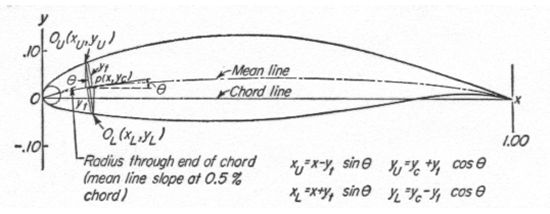|
||||||||||
|
|
||||||||||
|
||||||||||
|
|
||||||||||
I'm currently working on plans to build an example of the S-3 Viking. However I'm totally stumped on the 4
Digit NACA numbers for the S-3. Could you explain the following NACA names?
Wing root: 0016.3-1.03 32.7/1.00
Wingfold: 0013.9-1.10 40/1.00
Wing tip: 0012-1.10 40/1.00
Horizontal Stabilizer root/tip: 2410-0.8 45/1.575 (inverted)
Vertical Stabilizer root: 0012-1.10 20/1.312
- question from Curtis Chance

As discussed previously, the basic NACA Four-Digit airfoils are described by four numbers. The first digit specifies the maximum camber in percentage of the chord (airfoil length), the second indicates the position of the maximum camber in tenths of chord, and the last two numbers provide the maximum thickness of the airfoil in percentage of chord. All but one of the examples mentioned above are symmetric airfoils with no camber, so the first two digits are both zero.
We have described the first series of numbers, but what of the remaining values after the dash? These digits describe the modifications made by German researchers. These changes are similar to those used in the modified NACA Four and Five Digit Series, but the Germans went further by specifying even more modifications. Let us first explain the names provided for the A-4 Skyhawk since these are a simplified version of the full designation system.
The first number after the dash specifies a leading-edge radius parameter. This parameter is defined as being equal to the radius of the leading edge divided by the square of the airfoil thickness. The value given after the second dash is the location of the maximum airfoil thickness in percentage of chord aft of the leading edge. For example, the NACA 0008-1.1-25 is thickest 25% back from the leading edge while the NACA 0005-.825-50 reaches maximum thickness halfway (50%) along its length.
The airfoil sections provided for the S-3 Viking demonstrate yet more examples of the modification system devised by the Germans. For this example, we will pick the wing root airfoil and more fully explain the purpose of each set of values.
The meanings of these values are specified below:
.3 = the same basic NACA 0016 airfoil shape that has been scaled up to 16.3% thick
1.03 = the leading edge radius parameter (LERP). This variable describes how rounded the nose of the airfoil is. LERP is equal to the radius of the nose divided by the square of the thickness (r/t2). Since the thickness is known to be 0.163, solve for the radius r:
The radius is defined in fractions of chord, so this airfoil has a nose radius equal to 2.74% of the length of the airfoil.
32.7 = the location of the maximum thickness in percentage of chord from the leading edge. In other words, the thickest point on the airfoil is located 32.7% chord back from the leading edge.
1.00 = trailing-edge angle parameter (TEAP). This variable describes the thickness of the trailing edge. It is determined by the following equation:
where
Since TEAP and t are both known, solve for τ:
In this case, t is 0.163 and TEAP is 1.00, so τ is equal to 0.323 radians (18.516 degrees).
The meanings of these values are specified below:
Related Topics:
Read More Articles:


|
Aircraft | Design | Ask Us | Shop | Search |

|
|
| About Us | Contact Us | Copyright © 1997-2023 | |||
|
|
|||